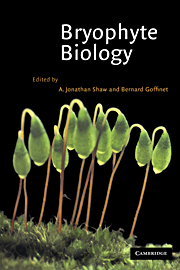Book contents
- Frontmatter
- Contents
- List of contributors
- Preface
- 1 Anatomy, development, and classification of hornworts
- 2 Morphology and classification of the Marchantiophyta
- 3 Morphology and classification of mosses
- 4 Origin and phylogenetic relationships of bryophytes
- 5 Chemical constituents and biochemistry
- 6 Molecular genetic studies of moss species
- 7 Control of morphogenesis in bryophytes
- 8 Physiological ecology
- 9 Mineral nutrition, substratum ecology, and pollution
- 10 Peatlands: ecosystems dominated by bryophytes
- 11 Role of bryophyte-dominated ecosystems in the global carbon budget
- 12 Population ecology, population genetics, and microevolution
- 13 Bryogeography and conservation of bryophytes
- Index
12 - Population ecology, population genetics, and microevolution
Published online by Cambridge University Press: 05 June 2012
- Frontmatter
- Contents
- List of contributors
- Preface
- 1 Anatomy, development, and classification of hornworts
- 2 Morphology and classification of the Marchantiophyta
- 3 Morphology and classification of mosses
- 4 Origin and phylogenetic relationships of bryophytes
- 5 Chemical constituents and biochemistry
- 6 Molecular genetic studies of moss species
- 7 Control of morphogenesis in bryophytes
- 8 Physiological ecology
- 9 Mineral nutrition, substratum ecology, and pollution
- 10 Peatlands: ecosystems dominated by bryophytes
- 11 Role of bryophyte-dominated ecosystems in the global carbon budget
- 12 Population ecology, population genetics, and microevolution
- 13 Bryogeography and conservation of bryophytes
- Index
Summary
Bryophytes have a number of life history characteristics that make them interesting and tractable organisms for population studies. Their life cycle is unique among land plants in having a free-living (usually) perennial gametophyte and an annual sporophyte that remains attached to the gametophyte throughout its life. The sporophyte obtains a significant proportion of its nutrients from the maternal gametophyte to which it is attached, although in mosses it is green and photosynthetic when immature and premeiotic (Proctor 1977). A specialized tissue comprised of transfer cells occurs on either the sporophyte or gametophyte side, or both, of the junction of the two generations, and facilitates the movement of metabolites between the gametophyte and sporophyte (Ligrone et al. 1993). This physiological connection, in addition to the obvious genetic relationship between gametophyte and sporophyte, must contribute to complex evolutionary patterns into which bryophytes offer unique opportunities for investigation (Shaw & Beer 1997).
Although it is often said that it is the gametophyte rather than the sporophyte that is exposed to the external environment, there is no empirical evidence to suggest that the sporophyte is completely or even mostly shielded from the forces of natural selection. Indeed, the fact that “life history strategies” can be recognized and include both gametophytic and sporophytic traits (During 1979, Longton 1997) implies a history of selection on traits in both generations. Evolution of the whole bryophyte plant must involve interactions between each generation and the external environment, as well as interactions, genetic and physiological, between the sporophyte and gametophyte generations of a single plant.
- Type
- Chapter
- Information
- Bryophyte Biology , pp. 369 - 402Publisher: Cambridge University PressPrint publication year: 2000
- 29
- Cited by



